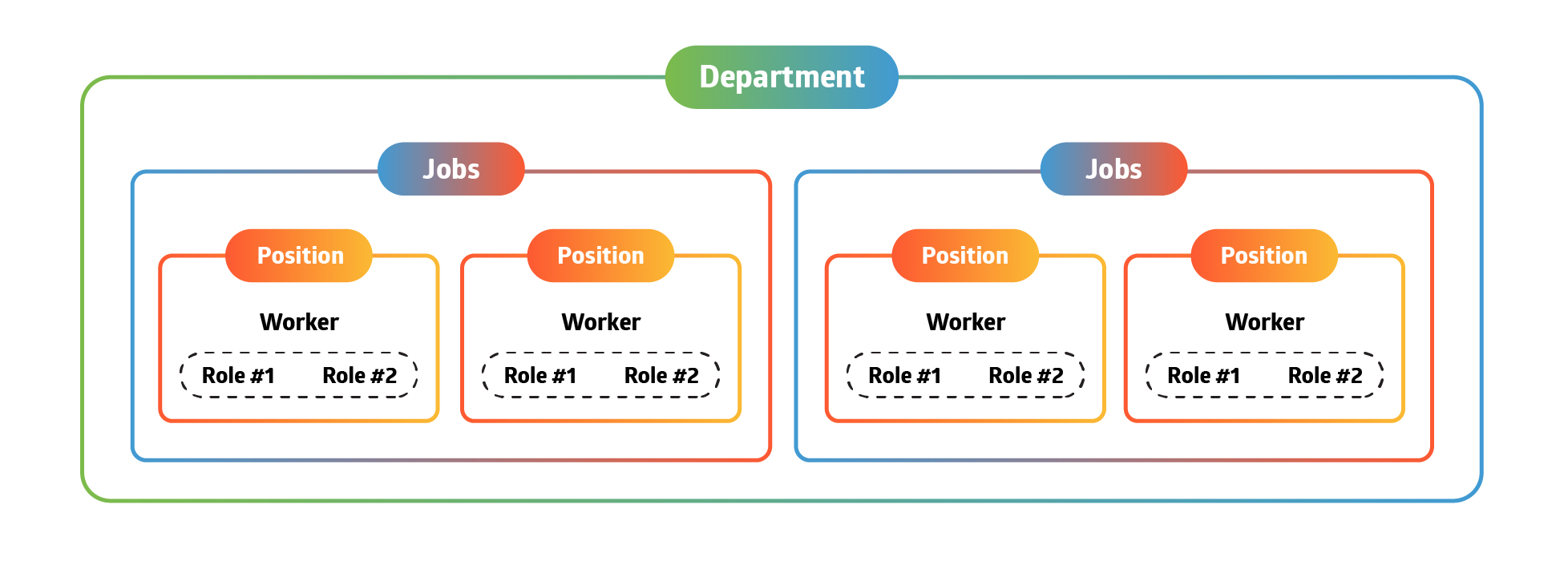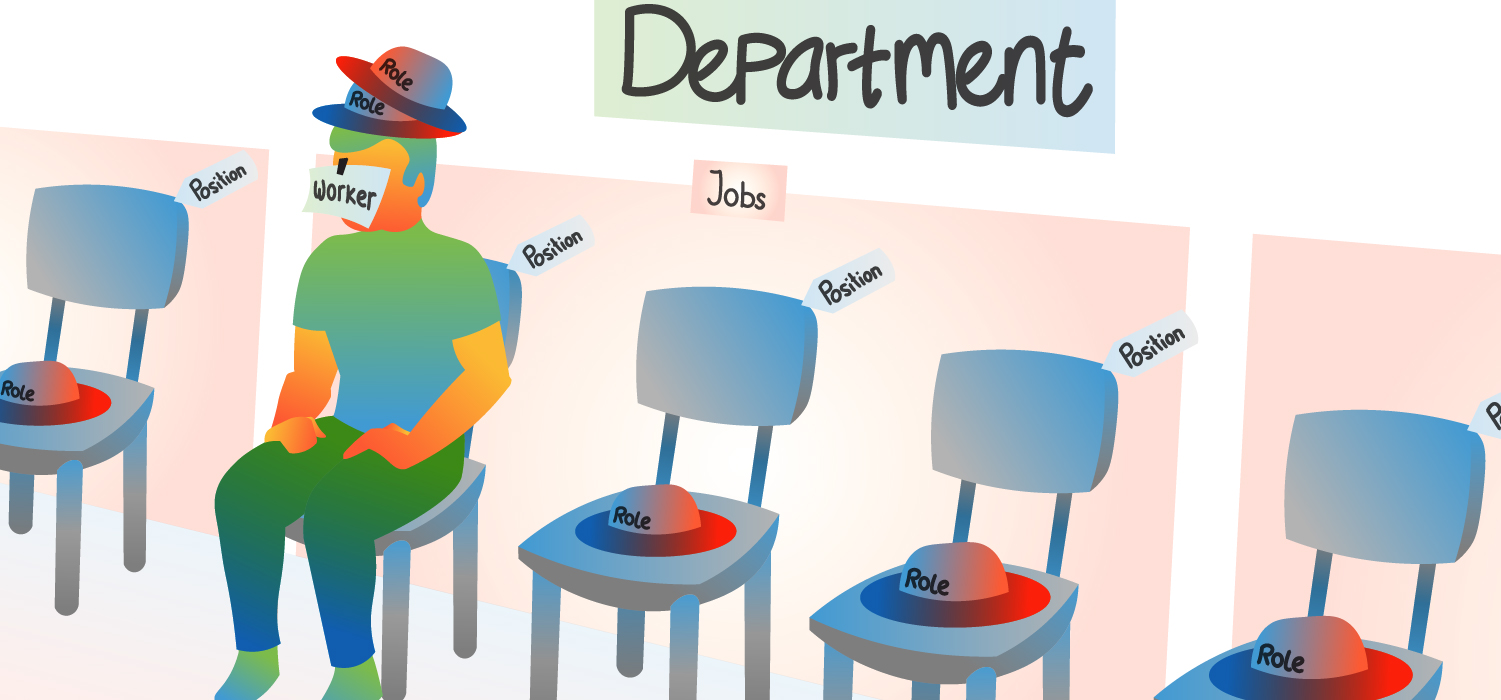The HR industry is loaded with terms and jargon, and to make things more complicated, these terms are also used differently depending on the context. In today’s fast-paced business landscape, understanding the nuances between these different HR management concepts is essential for fostering a thriving workforce.
In this article, we clarify a few HR terms and showcase how to lay the foundation for specific HCM processes supported by advanced HR applications.
What are Positions, Jobs, and Roles in Human Resource Management?
In Human Capital Management (HCM) and recruitment, we often use these foundational interchangeably, but recognizing their strategic distinctions is crucial. Ensuring a common understanding of these terms is essential to align line managers, HR personnel, and recruiters to work towards common goals. Positions, jobs, and roles are at the core of organizations, but how much weight job titles and positions carry at an individual level is often debated. Some argue that overemphasizing these labels might not necessarily translate into financial gains, but understanding the nuances between these terms can significantly benefit those seeking career progression. A recent study highlights that 76% of individuals are keen on advancing their careers, stressing the need for understanding the role of job titles and positions in career growth.
Let’s unpack these three terms along with two additional commonly used ones.
- Position: A specific employment opportunity with distinct tasks and responsibilities, often tied to a job title. Multiple individuals can hold the same job.
- Job: A collection of related positions or roles with shared responsibilities. Clearly defining roles enhances candidate selection and improves the employee experience and organizational efficiency.
- Role: Represents a broader function within an organization, encompassing contributions beyond a single position’s tasks. Roles are sometimes used interchangeably with positions or jobs.
- Worker: Refers to individuals fulfilling tasks based on positions or roles, including employees and contractors.
- Function: These distinct areas within an organization handle specific tasks. Functions like HR, Finance, and Marketing have unique roles, positions, and jobs and oversee HR processes and activities.
Understanding these terms equips you to effectively engage with line managers, HR teams, and recruiters professionally.
What are Positions, Jobs, and Roles in HR management software?
While these three terms are often employed interchangeably in practice, within the context of Human Resource Management (HRM) software, they hold specific and vital roles in overseeing an organization’s workforce. In this instance, we refer to the terms used in Microsoft’s HR management software – Dynamics 365 F&O:
| Positions | Within a centralized database, positions are meticulously defined and managed. Each position is linked to a distinctive job title, and its description encompasses precise tasks, responsibilities, requisite qualifications, and reporting hierarchies. HR managers can establish, modify, and archive positions as necessary, ensuring the organization’s structure remains well-defined and adequately maintained. Positions find relevance within Core HR systems and Workforce Planning. |
| Roles | Roles encapsulate broader categories or clusters of positions that share analogous functions, responsibilities, and skill prerequisites, e.g., Manager. These roles contribute to the organization of positions and facilitate streamlined recruitment, training, and performance management processes. Roles and security roles do not have the same application and should not be confused. |
| Jobs | As a way of grouping akin positions based on specific criteria such as department, location, skillset, or seniority level, jobs offer a helicopter view of the workforce. They empower HR professionals to analyze and administer employee data effectively and efficiently. |
| Workers | In HR software, workers denote the employees who occupy specific positions or fulfill designated organizational roles. Each worker is linked to a particular position, and their pertinent data, such as personal details, job history, performance evaluations, and training records, are meticulously stored and managed within the HR Management system. |

What is the difference between a Position, Job, and Hiring requisition?
Simply put, the position requisition kicks off the evaluation process for a new position, the job requisition seeks approval to fill an existing position, and the hiring requisition is the green light to start hiring. While these terms are often used interchangeably, they can have nuanced differences based on an organization’s unique processes and system setup.
Position Requisition – requesting a new position to be created:
- Primarily involves a formal ask from a (line) manager to HR, aiming to establish a new role within a department. This need might arise due to company growth, increased workload, or the formation of a new department.
- This request outlines vital role details like job title, description, qualifications, reporting structure, and budget. Once given the nod, it sets the foundation for upcoming recruitment endeavors.
Job Requisition – seeking approval to fill an existing vacancy:
- Typically involves a formal request to fill a vacant position within the organization. This documented process sparks internal recruitment activities, specifying the position’s requirements, experience, and qualifications.
- A job requisition typically comes into play when replacing a departed employee or when an employee transitions to another role within the organization.
Hiring requisition – the go-ahead to start recruiting for an open position:
- Usually entails a formal proposal from a hiring manager or department to the HR or recruitment team, asking for the green signal to begin the recruitment process for a specific role. Once approved, the hiring team can kickstart candidate search and selection through a recruitment and candidate management system.
- This requisition encompasses job title, description, desired qualifications, and budget considerations, like salary range.
It’s worth noting that these terms might even differ across various software vendors. For instance, while Microsoft Dynamics 365 HR uses “job requisition,” many recruitment and hiring systems (ATS), like iCIMS, refer to it as hiring requisitions.
This is where FourVision’s integration tool, HR Request, shines by offering full customization to cater to each customer’s particular needs. We help you to document your processes, set up organizational structures-and hierarchies, define roles, and set up workflows to keep up with your business priorities.
Difference between Roles, Jobs, and Positions in Performance Management
Crafting well-defined positions and roles within departments serves as the bedrock of effective performance management. This ensures that employees’ endeavors align with the organization’s expectations, ultimately steering towards the achievement of desired business outcomes.
Another pivotal aspect of performance management is utilizing a job matrix – a strategic tool for delineating departments, the positions entrenched within them, and the progressive career pathways toward specific roles. Related to this are competencies. This term encompasses skills, knowledge, abilities, and behaviors and denote the essential attributes employees require to execute their job responsibilities proficiently.
Leveraging the insights gleaned from Microsoft’s Dynamics 365 HR system, businesses can embark on the journey of Advanced Performance Management, propelling their operational excellence to new heights.




